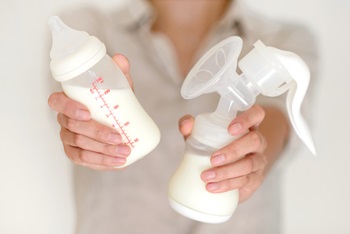Pump and Store: Tips for Getting the Most Out of Every Ounce

All things being equal, it’s a whole lot easier to just breastfeed your baby than to pump and store your breast milk for later use. But, all things are rarely equal. Many moms go back to work after a few weeks, and sometimes mom just wants a night out (or a night off for sleeping), and pumping is the way to go. To make sure that your pumped breast milk is just as nutritious and safe as milk straight from the source, there are a few guidelines that can be helpful.
Pumping Guidelines
Make sure your hands are clean and that your pump (if used) and all its parts are clean and sanitized. Ideally, use a pump that features tubing that never comes into contact with the milk (it’s only used to provide suction)—tubing that carries milk is notoriously difficult to keep clean and sometimes grows mold.
Storage Guidelines:
- Prepping for storage
Breast milk storage bags are ideal for long-term storage because they take up less space than bottles or other containers. For short-term storage (just a few hours), bottles work fine—just make sure they are food-grade glass or plastic, and that they have tight-fitting lids. If the milk isn’t going to be used that same day, clearly label the container with the date.
If you plan to freeze your milk in bags, be sure to place them flat on the freezer shelf, so that they freeze in neat little squares. You can then put them in bins according to date, like a convenient filing system. If you use other containers, freeze the milk in small amounts (two to four ounces). Either way, don’t fill the container completely full, as the milk will expand as it freezes.
- Locations, temperatures and timelines
Freshly pumped milk can be stored on the counter, at room temperature, for up to four hours. You can keep it in the refrigerator for up to four days. If you keep it in a freezer, the type of freezer determines how long you can store it: up to two weeks for a freezer compartment within a refrigerator; three to six months for a freezer compartment with a separate door; 6 to 12 months for a deep freezer. Note: If you don’t plan on using the milk within four days, place it immediately in the freezer. Always keep breast milk in the back of the freezer, where it’s the coldest.
- Thawing and serving
Use the “first in, first out” rule, so that you always use the oldest milk in the freezer. This prevents winding up with really old milk stuffed in the back of your freezer. You can thaw it overnight in the refrigerator, as long as you use it within 24 hours. Or, you can run the sealed container under warm running water to thaw and warm up. Once the milk is warmed, swirl it around (don’t shake) to mix the fat back in with the rest of the milk. If baby doesn’t finish the milk, don’t refreeze it. It can be safely stored on the counter for up to two hours, but then it needs to be used or thrown away.
All new moms need lots of help and support during the first days and weeks at home. This is especially true for breastfeeding moms. Research shows that easily accessible help from a knowledgeable, caring breastfeeding professional is a key factor in helping mothers meet their personal goals. Consider scheduling a lactation consultation by calling (813) 872-3932.
